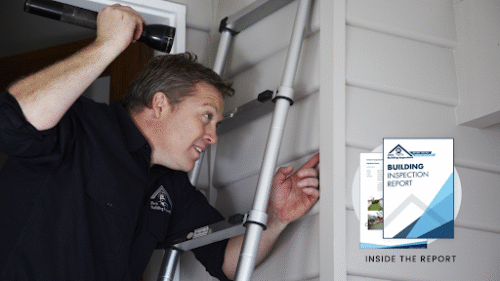When most people think about a property inspection report, they imagine uncovering major structural issues or urgent safety hazards. But part of what makes a professional inspection so valuable is the thoroughness of the process. Our inspectors also look for minor defects—the smaller issues that might not pose immediate risks but are worth recording for future maintenance.
Recently, during a home inspection in Papatoetoe, Auckland, our team identified several minor issues that highlight the importance of detailed inspections. Let’s take a closer look at how these are identified and why they’re included in the report.
Minor Defects – What Was Found
During the inspection of this Auckland property, the inspector also identified several minor defects. These included:
– Exposed building paper under the eaves
– Bird debris near the roofline
– Gutter and valley debris, including vegetation
– Surface blemishes from nail fixings
– Hairline cracks in weatherboards
While these are not major problems, our professional inspectors document them in the property condition report so property owners are fully informed and can plan maintenance as needed.

Why These Small Issues Are Included
Minor defects don’t usually signal urgent repair needs, but they’re still recorded in the property inspection report because they can help owners stay proactive. For example:
- Exposed Building Paper – Building paper is designed to be protected. If left exposed, it can deteriorate more quickly.
- Bird and Gutter Debris – Organic matter traps moisture, which can cause damage if left for too long.
- Nail Fixing Blemishes – Small blemishes may lead to water ingress or faster paint wear.
- Hairline Cracks in Weatherboards – These can let in moisture over time if not sealed.
Recording these helps the owner take preventive action before problems arise.

How Professional Inspectors Detect Minor Defects
At Jim’s Building Inspections, our inspectors take a systematic approach:
- Close visual inspections – Checking under eaves, around gutters, and along exterior walls.
- Photographic evidence – Documenting cracks, blemishes, and debris for transparency.
- Moisture testing – Ensuring cracks or timber aren’t already letting in water.
- Condition grading – Clearly labelling issues as minor, significant, or hazardous so clients know where to prioritise.
This level of detail in a building inspection ensures nothing is overlooked, even if it seems insignificant at first glance.
Why Minor Defects Shouldn’t Be Ignored
Although minor defects are not urgent, they provide valuable information for property care:
- Prevention is cheaper than repair – Simple maintenance now can avoid bigger costs later.
- Maintenance planning – Owners can schedule small fixes before they escalate.
- Negotiation tool – Buyers can still use documented minor issues in property negotiations.
Case Study: Papatoetoe Home Inspection
In the Papatoetoe case, the property was generally in good condition with no major or urgent defects. However, our inspector also documented a range of minor defects to provide the buyer with a comprehensive picture of the property. This helped the buyer plan for:
- Immediate gutter cleaning.
- Sealing weatherboard cracks.
- Monitoring exposed building paper for deterioration.
By listing these minor issues, the inspector ensured the client had a thorough understanding of the property’s overall condition.
Conclusion
A property inspection report isn’t just about finding major problems—it’s also about providing a full picture of the property’s condition. Our professional inspectors include detailed minor defects, so buyers and owners know what to maintain to protect their investment.
At Jim’s Building Inspections, our detailed approach ensures that every detail—big or small—is clearly documented, giving you confidence and peace of mind. Looking to buy or maintain a property in Auckland or anywhere in New Zealand? Book your building inspection with Jim’s Building Inspections and get a detailed, professional property inspection report that covers everything from major defects to the smallest maintenance issues.
Disclaimer: This article is based on a case study property inspection in Auckland. Actual property inspection reports may differ depending on the property type, age, condition, and the specific needs of the customer. For professional advice and a tailored property inspection report, please contact Jim’s Building Inspections.
FAQs
Yes. You can download a free sample report to see the level of detail and clarity we provide in every inspection.
Usually 2–4 hours, depending on the property size.
Yes, buyers often use reports to request repairs or adjust their offer.
Yes, insurers may consider the findings when offering coverage.
Yes, even new builds can have defects.
Yes, hazards are flagged and prioritised.
A pre-purchase building inspection helps buyers make informed offers, while a pre-sale inspection helps sellers prepare their property for the market.



